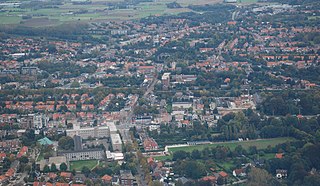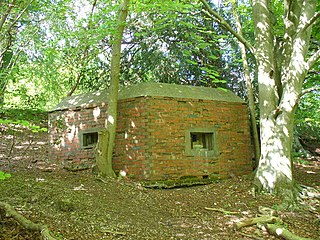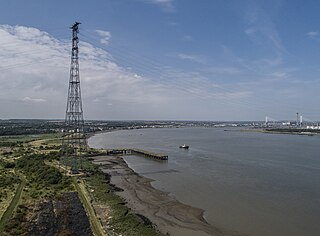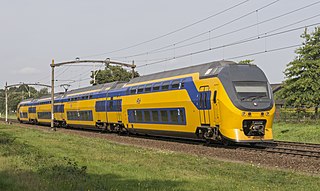The Crossing the Lines project brings the communities of Utrecht (the Netherlands) and Mortsel (Belgium) and the County of Essex (Great Britain) together to protect and redevelop flood defence lines in Northwest Europe in an environmentally sustainable manner.
This partnership will develop the defence lines of "Nieuwe Hollandse Waterlinie" (Utrecht), the east coast of the UK (Essex) and "Vesting Antwerpen" (Mortsel).

Mortsel is a city and municipality close to the city of Antwerp located in the Belgian province of Antwerp. The municipality only comprises the city of Mortsel proper. In 2021, Mortsel had a total population of 26,170 people. The total area is 7.78 km².

The River Roding rises at Molehill Green, Essex, England, then flows south through Essex and London and forms Barking Creek as it reaches the River Thames.

The Outer London Defence Ring was a defensive ring built around London during the early part of the Second World War. It was intended as a defence against a German invasion, and was part of a national network of similar "Stop Lines".

The Dutch Waterline was a series of water-based defences conceived by Maurice of Nassau in the early 17th century, and realised by his half brother Frederick Henry. Combined with natural bodies of water, the Waterline could be used to transform Holland, the westernmost region of the Netherlands and adjacent to the North Sea, almost into an island. In the 19th century, the Line was extended to include Utrecht.

Alresford railway station is on the Sunshine Coast Line, a branch of the Great Eastern Main Line, in the East of England, serving the village of Alresford, Essex. It is 57 miles 63 chains (93.0 km) down the line from London Liverpool Street and is situated between Wivenhoe to the west and Great Bentley to the east. In official literature it is shown as Alresford (Essex) in order to distinguish it from the station of the same name in Hampshire. Its three-letter station code is ALR.

Althorne railway station is on the Crouch Valley Line in the East of England, serving the village of Althorne, Essex. It is 40 miles 27 chains (64.92 km) down the line from London Liverpool Street and is situated between North Fambridge to the west and Burnham-on-Crouch to the east. The station is managed by Greater Anglia who operate all services. The Engineer's Line Reference for line is WIS; the station's three-letter station code is ALN. The single platform, north of the running line, has an operational length for eight-coach trains.
The Morris & Essex Lines are a group of former Delaware, Lackawanna and Western Railroad (DL&W) railroad lines in New Jersey now owned and operated by NJ Transit. The lines include service offered on the Morristown Line and the Gladstone Branch. Prior to 2002, the former Montclair Branch, now part of the Montclair–Boonton Line, was included as well. The name refers to the Morris and Essex Railroad, which originally constructed the lines before being leased by the DL&W in 1868, and later outright acquired in 1945.

Roseville Avenue was a transfer station on New Jersey Transit's Morris & Essex Lines in Newark, New Jersey, United States. The station was built by the Delaware, Lackawanna and Western Railroad in 1903 as part of a project to lower the tracks below the road surface to eliminate grade crossings. It serviced Newark's Roseville neighborhood. It once had two tracks on the Lackawanna mainline and two low-wall platforms, with an additional platform along the Montclair Branch. The station remained in service during most of the 20th century, until New Jersey Transit closed the station on September 16, 1984.

The 400 kV Thames Crossing is an overhead power line crossing of the River Thames, between Botany Marshes in Swanscombe, Kent, and West Thurrock, Essex, England. Its towers are the tallest electricity pylons in the UK.

Rail transport in the Netherlands uses a dense railway network which connects nearly all major towns and cities. There are as many train stations as there are municipalities in the Netherlands. The network totals 3,223 route km (2,003 mi) on 6,830 kilometres (4,240 mi) of track; a line may run both ways, or two lines may run on major routes. Three-quarters of the lines have been electrified.

Woerden railway station is the railway station of Woerden, Netherlands. The railway station was opened on 21 May 1855 on the Utrecht–Rotterdam railway. In 1911 a new building was built in Jugendstil, that still exists. During 1993-1996 the railway station was modernised, replacing the wooden roof and stairways by modern ones.

The Belgian railway line 25 is the oldest railway line in Belgium. It connects Belgium's two main cities: Brussels and Antwerp. The section between Brussels and Mechelen was completed in on 5 May 1835 and was the first railway in Belgium and the first public passenger steam railway on the European continent. On 3 May 1836 the second section, between Mechelen and Antwerp, was opened. It was extended to Luchtbal in the north of Antwerp in 2007 in order to shorten the route from Amsterdam to Brussels. The total line runs 47.6 km (29.6 mi).

The Montclair-Boonton Line is a commuter rail line of New Jersey Transit Rail Operations in the United States. It is part of the Hoboken Division. The line is a consolidation of three individual lines: the former Delaware, Lackawanna & Western Railroad's Montclair Branch, which ran from Hoboken Terminal to Bay Street, Montclair; the Erie Railroad's Greenwood Lake Division, which originally ran from the Erie's Jersey City Terminal to Greenwood Lake, NY; and the former Lackawanna Boonton Line, which ran from Hoboken to Hackettstown, New Jersey. The Montclair-Boonton line was formed when the Montclair Connection opened on September 30, 2002. The line serves 28 active rail stations in New Jersey along with New York Pennsylvania Station. It crosses through six counties, serving six stations in the township of Montclair, two in the town of Bloomfield, and one in the city of Newark. Trains along the Montclair-Boonton Line heading eastward usually originate at Hackettstown, Mount Olive, Lake Hopatcong, Dover, or Montclair State University, bound for either Hoboken Terminal or New York Penn Station. On system maps the line is colored maroon and its symbol is a bird, after the state bird, the eastern goldfinch.

Hanke Gerdina Johannette Bruins Slot is a Dutch politician, jurist and military veteran, who has served as Minister of the Interior and Kingdom Relations since 10 January 2022 in the fourth Rutte cabinet. A member of the Christian Democratic Appeal (CDA), she previously served in the House of Representatives from 2010 to 2019. Bruins Slot focused her work as a parliamentarian on matters of defence personnel, local government, healthcare science, medical law, psychiatry and sports.

The Amsterdam–Arnhem railway, also referred to as the Amsterdam–Elten railway or Rhijnspoorweg in Dutch, is an important railway that connects Amsterdam in the Netherlands with Utrecht and Arnhem, and continues into Germany.

The Belgian railway line 15 is a railway line in Belgium connecting Antwerp with Hasselt. It was opened between 1855 and 1925. The total length of the line between the Drabstraat junction and the Zonhoven junction is 92.1 km. Line 15 is not the shortest or fastest connection between Antwerp and Hasselt: the faster trains take the 14 km shorter route through Lier, Aarschot and Diest.

The Utrechtse sneltram is a light rail system in the Dutch city of Utrecht. The system consists of three tram routes connecting Utrecht Centraal railway station with the residential areas of Lombok and Kanaleneiland and the suburbs Nieuwegein and IJsselstein to the southwest of the station, and with the Uithof district and Utrecht University to the southeast.

Mortsel-Liersesteenweg is a railway station in Mortsel, just south of the city of Antwerp, Antwerp, Belgium. The station opened in 1933 as Mortsel-Oude-God on Line 27. The station closed in 1939 and re-opened in December 2008.
The Nederlandsche Centraal-Spoorweg-Maatschappij (NCS) was founded on 20 February 1860 in Amsterdam and established in Utrecht from 1876 and was dissolved on 23 May 1934. The Central Railway Utrecht – Amersfoort – Zwolle – Kampen was constructed by the NCS.

The Battle of Gunnislake New Bridge was a battle that took place on 20 July 1644 on and around Gunnislake New Bridge, a bridge over the River Tamar between Cornwall and Devon, during the First English Civil War.